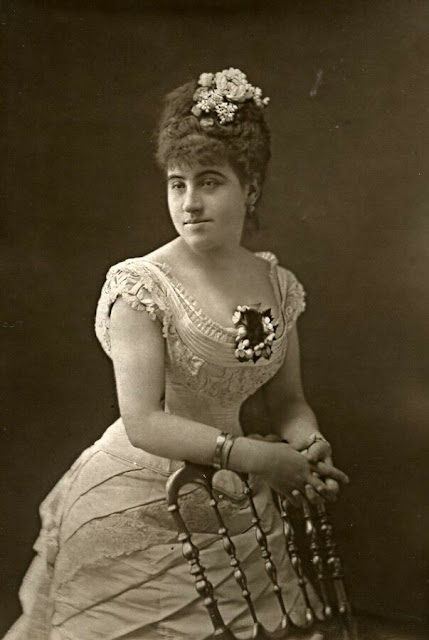In 2019, Offenbach year, I penned a little piece about the original (and mostly forgotten) girls of his Bouffes-Parisiens company ..
https://kurtofgerolstein.blogspot.com/2019/06/ladies-of-bouffes-parisiens-1855-1860.html
Yes, 1855-1860.
On another occasion, attracted by a photo of a later member of the famous theatre's troupe, I took another couple of swings at the 'who was' of the girls (the men being, often, famous and well 'done') ..
https://kurtofgerolstein.blogspot.com/2020/03/girls-of-bouffe-parisiens-noriac-years.html
This week, by a roundabout process, I came upon a photo of another Bouffes lassie ... 1864-5 ... and realised that there was a culpable gap of some years between my article (a) and my article (b). So I decided to 'do' Mademoiselle Lovato. And, of course, I got led astray into the endlessly fascinating 1860s.
But let's start with
Marie [Adèle] LOVATO (b Paris 30 June 1844; d Paris October 1915), daughter of Jean-Baptiste (or Giovanni Battista) Lovato and his wife Geneviève Joséphine de la Torre (m 9 September 1841).
Marie entered the Paris Conservatoire in her teens, studied under Mlle Hersant, Morin, Mocker et al, but only squeaked into the prizes with a 3ème and 2ème accessit in opéra-comique ...
The judges must have been feeling grouchy that year. Marie Roze and Eugénie Mauduit were not judged worth a first (They got it next time!). And the men's opera class weren't awarded a first or a second.
 |
| Eugénie Mauduit |
Marie didn't have to worry. She had already been honing her art, singing in the chorus at the Opéra, and at her graduation she was snapped up by the Bouffes.
She made her first appearance there 29 September 1864 in La Maison de Larenadière ('voix sympathétique') alongside Irma Marié and Clarisse Miroy, and I see her thereafter as Lise in L'Homme entre deux ages with Heuzey and Geraldine, as Zoe in Grisar's Les Douze Innocents, in C'est pour ce soir, Bonsoir M Pantalon, Caspers's Le Cousin Babylas, Roland à Ronge-Veau, Le Mariage aux lanternes and with the company in their season at Ems (Le Lion de St Marc, Le Maître de Chapelle, the original Delfina in Coscoletto).
 |
| Lovato |
 |
| Heuzey |
However, she did not remain the Bouffes. She took an engagement for South America, supporting Marie Aimée, and did not return to Paris until mid-1867, when she was engaged for the new Théâtre de l'Athénée. She played in Malbrouk s'en-va t'en guerre (Bobinette), L'Amour et son carquois (Thisbé to the Amour of Irma Marié), Césarine in Fleur de Thé, Aventurine in Le Petit Poucet, Rosette in Les Jumeaux de Bergame, Wilhelmine in Les Horreurs de la Guerre, and was loaned out to the Palais-Royal to deputise for Céline Montaland as the Baronne de Gondremarck.
From the Athénée she moved to the Folies-Dramatiques where she created the role of Marguerite in Jonas's Le Canard à trois becs ('un excellente chanteuse') and seemingly took turns in Le Petit Faust and Les Turcs, in 1869 she returned to the spa circuit, and then was engaged -- along with Lise Tautin -- for the French opéra-bouffe at St Petersburg. And there, her 'international' travels came to an end. Yes, it was a man.
Marie was reported to have eloped. But I see her still there in 1872 (Gabrielle in Les Cent Vierges). Anyway, she married 'Signor Campo-Casso' or 'Campocasso', former manager of the theatres at Lille Algiers, Angers and Toulouse 26 June 1873, and became Madame Marie Deloche. Campo's real name was Auguste Deloche. Campo was on a rising arc, and the couple removed to Brussels where Madame made her debut as Madeleine in Le Postillon de Lonjumeau.
Thereafter they followed Auguste's appointments to Marseille, Paris, Rouen, Lyon ... with Marie appearing less frequently ...
Campo died in 1908. Marie 7 October 1915.
That was to be it, but another name in that depressing prize-list caught my eye. Mademoiselle Seveste.
Jacqueline Angélique Julie Laure SEVESTE (b Montmartre 7 August 1844; d Nantes 13 December 1927) has made her way into several reference works (including Larousse!) but not strictly for her vocal triumphs.
She was from a family which had had a presence in the Paris theatre -- manageent at the Comédie Français and the Théâtre Lyrique, and her brother, Didier, was a prized juvenile at the Français. She stayed on at the Conservatoire after Marie had left for the Bouffes, and eventually (1866) her 'suave voix' and 'naturel' gained her a premier prix for opéra-comique. She made her first appearance at the Opéra-Comique in 1866 in L'Epreuve villageoise ('très avenante .. quelquechose à apprendre comme chanteuse ... charmante artiste') and played there in such little pieces as Les Sabots de la Marquise, Mademoiselle Sylvie, in Betly, as Jasmin in Les Rendezvous bourgeois, Le Chien du Jardinier, with Couderc in Maître Pathelin before disappearing from the books.
 |
| Couderc |
She seems to have retreated into the world of the private-house and concert operetta, but she was propelled to the fore when 25 year-old brother, Didier, was killed in the Siege of Paris. His death was made into a rather James-Deanish affair, and Marie sustained his memory vigorously.
She also returned to the stage, cast as the ingenue Rosée du soir in the spectacular Le Roi Carotte. She fulfilled the 'pretty girl, sweet voice' requirements of the part efficiently, but then returned to concerts and the salons.
I don't see her back on the stage until 1875 ('une chanteuse légère dans le vrai sens du mot') singing at Montpellier in mostly the opéra-comique repertoire (La Fille du régiment, Le Barbier de Séville, Les Dragons de Villars, Les Mousquetaires de la Reine, La Dame Blanche, Les Noces de Jeannette ... and La Traviata!) and then, after appearance at Nantes, Dijon, the Contrexéville Casino et al, until in 1879 she returned to Paris as prima donna of the Opéra Populaire at the Château d'Eau. Now she sang Martha, Si j'étais roi, Le Barbier de Séville (with good old Rode's Variations), Fanchonette and ... Lucia di Lammermoor. If her voice had, apparently, taken on a wee bit of volume, so had her body. 'Stout'.
I see her, over the next decade, giving La Perle du Brésil at Reims, Hamlet in Amsterdam, L'Etoile du Nord and Mignon at Angers, Le Diamants de la Couronne at Mont Doré, Galathée and Faust at Rouen, Don Pasquale at Geneva, and in 1884 Il Trovatore, Traviata, Roméo et Juliette, Le Desert and Clairette in La Fille de Madame Angot plus repeats of her favourites Barbier, Noces de Jeannette ...
Now she was not only stout, but her voice was showing the strains of age and Verdi. But I see her battling on, as late as 1891, in her adopted home of Nantes.
In the 1880s (?), she married the Mayor of Nantes, Edouard Normand (1818-1896), and was left a very wealthy widow at his death. She devoted herself to good works, holding a daily crêche in the grounds of their estate, (she gave part of the land to the city), and also working, ever, in favour of the memory of her brother. The government gave her a cross and a ribbon for Didier, and later the Légion d'honneur for herself. Someone claimed they had found his sword, and it was apparently enshrined in the foyer of the theatre ... true?
She had been a capable, light-soprano, provincial prima donna. The awards were for her achievements as a woman.
Here's another 3ème accessit. From 1867, this one. A certain Zélie Anna de Rasse from Belgium was judged to merit a premier prix, and duly headed for the Opéra-Comique. But, it was announced, so did the 3ème accessit.
Anna Marie LABRUNIE (b Paris 2 September 1849; d Bayonne March 1927) was the apparently fatherless daughter of Anna Albertine Marie Labrunie. She studied with Couderc at the Conservatoire, and probably owed to him her place at the Opéra-Comique. The only thing is, I can't actually see her playing in anything there, yet this photo is supposed the be her in the role of Cupid in Orphée aux enfers. Which quite simply don't fit.
Maybe there was a later Mlle Labrunie? Anyway, our one married (17 December 1871, with Couderc as witness) a young baritone from the Opéra-Comique (briefly), Jean-Ernest Masson, and as far as I know, wasn't seen on the Paris stage again, appearing only in concert, often with her husband, over the years that followed. He, too, left the stage and became adjoint prof to his teacher, Fauré, at the Conservatoire, where he established himself as a well-known and successful teacher.
Marie also taught, and produced four sons, of whom the best-known was Louis Marie Jean Masson, Masson, who would later become supremo at the Trianon-Lyrique and the Opéra-Comique. Georges (who lost a leg in the war) made a career as an artist, Adrien Henri Louis (an international fencer) at the head of the Savonnerie de la Côte d'Argent at Bayonne, and Octave Lucien Pierre Jacques, an antique dealer.






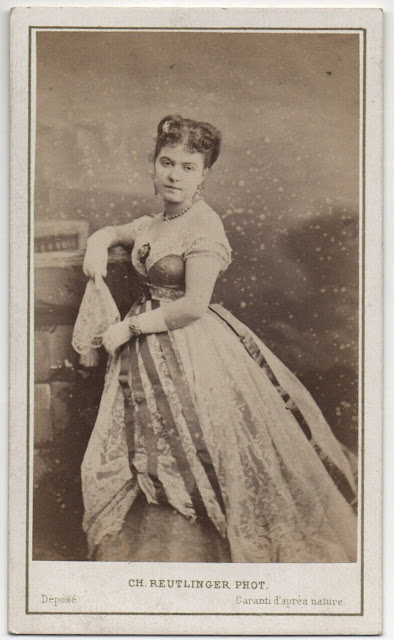
















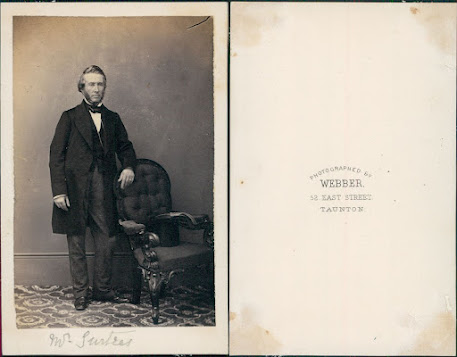













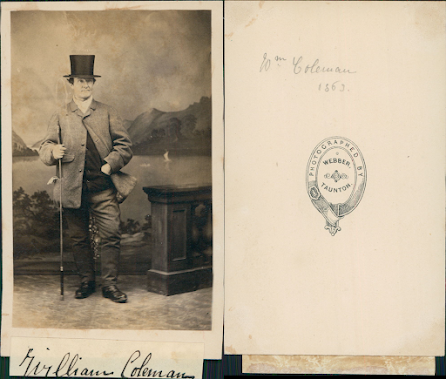


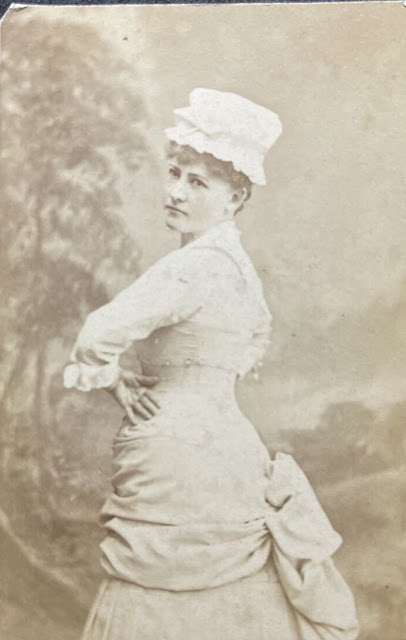
Offenbach_Jacques_bpt6k317546z.jpg)





